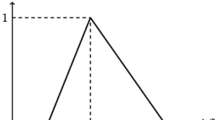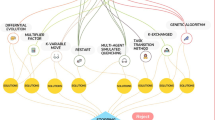Abstract
Vegetable wholesaling problem has a vital role in the business system. In this problem, a vegetable wholesaler is supposed to supply raw, fresh vegetables to supermarkets in an efficient way by minimizing time but maximizing profit. In this paper, we have presented a multi-resource multi-objective knapsack problem (MRKP) for vegetable wholesalers. This model is beneficial for a vegetable wholesaler who collects different types of vegetables (objects) from different villages (resources) to a market for selling the vegetables (objects). MRKP is an extension of the classical concept of 0–1 multi-dimensional knapsack problem (KP). In this model, precisely a wholesaler has a limited capacity van/trolley by which he/she collects a set of vegetables from different villages/vegetable fields. In this model, we have assumed that all the vegetables are available for each resource. Each type of vegetable is associated with a weight, a corresponding profit, and a collection time (for a particular resource). The profit, weight, and collection time of objects is different for different resources. Here a time slice is considered for each object to collect it from different villages to a particular destination/market. Also, the profit and time are the two objectives. MRKP aims to find the amount of an object and the corresponding resource name from which it is collected. We have solved the proposed problem in the fuzzy environment. In this paper, we have explained two defuzzification techniques, namely fuzzy expectation and total \(\lambda\)-integral value method to solve the proposed problem. We have explained a modified multi-objective genetic algorithm (NSGA-II by Deb et al. in IEEE Trans Evol Comput 6(2):192–197, 2002) that is to maximise the profit and minimise the time to collect the objects. We have considered a multi-objective benchmark test function to show the effectiveness of the proposed Genetic Algorithm. Modification is made by introducing refinement operation. An extensive computational experimentation has been executed that generates interesting results to establish the effectiveness of the proposed model.







Similar content being viewed by others
References
Aisopos F, Tserpes K, Varvarigou T (2013) Resource management in software as a service using the knapsack problem model. Int J Prod Econ 141(2):465–477
Bagchi A, Bhattacharyya N, Chakravarti N (1996) LP relaxation of the two dimensional knapsack problem with box and GUB constraints. Eur J Oper Res 89(3):609–617
Balasubbareddy M, Sivanagaraju S, Suresh CV (2015) Multi-objective optimization in the presence of practical constraints using non-dominated sorting hybrid cuckoo search algorithm. Eng Sci Technol Int J 18(4):603–615
Balev S, Yanev N, Freville A, Andonov R (2008) A dynamic programming based reduction procedure for the multidimensional 0–1 knapsack problem. Eur J Oper Res 186(1):63–76
Bektas T, Oguz O (2007) On separating cover inequalities for the multidimensional knapsack problem. Comput Oper Res 34(6):1771–1776
Bonyadi MR, Li X (2012) A new discrete electromagnetism-based meta-heuristic for solving the multidimensional knapsack problem using genetic operators. Oper Res 12(2):229–252
Boyer V, Elkihel M, Baz DE (2009) Heuristics for the 0–1 multidimensional knapsack problem. Eur J Oper Res 199(3):658–664
Changdar C, Mahapatra GS, Pal RK (2013a) An ant colony optimization approach for binary knapsack problem under fuzziness. Appl Math Comput 223:243–253
Changdar C, Mahapatra GS, Pal RK (2013b) Solving 0-1 knapsack problem by continuous ACO algorithm. Int J Comput Intell Stud 2(3/4): 333–349
Changdar C, Mahapatra GS, Pal RK (2014) An efficient genetic algorithm for multi objective solid travelling salesman problem under fuzziness. Swarm Evol Comput 15:27–37
Changdar C, Mahapatra GS, Pal RK (2015) An improved genetic algorithm based approach to solve constrained knapsack problem in fuzzy environment. Expert Syst Appl 42(4):2276–2286
Dai C, Wang Y, Ye M (2015) A new multi-objective particle swarm optimization algorithm based on decomposition. Inf Sci 325(20):541–557
Damghani KK, Nojavan M, Tavana M (2013) Solving fuzzy multidimensional multiple-choice knapsack problems: the multi-start partial bound enumeration method versus the efficient epsilon-constraint method. Appl Soft Comput 13(4):1627–1638
Deb K, Pratap A, Agarwal S, Meyarivan T (2002) A fast and elitist multiobjective genetic algorithm: NSGA-II. IEEE Trans Evol Comput 6(2):192–197
Dehuri S, Patnaik S, Ghosh A, Mall R (2008) Application of elitist multi-objective genetic algorithm for classification rule generation. Appl Soft Comput 8(1):477–487
Dey S, Roy TK (2014) A fuzzy programming technique for solving multi-objective structural problem. Int J Eng Manuf 5:24–42
Dhodiya JM, Tailor AR (2016) Genetic algorithm based hybrid approach to solve fuzzy multi-objective assignment problem using exponential membership function. SpringerPlus 5(1):2028
Fallah AA, Makhtumi Y, Pirali-Kheirabadi K (2016) Seasonal study of parasitic contamination in fresh salad vegetables marketed in Shahrekord, Iran. Food Control 60:538–542
Fleszar K, Hindi KS (2009) Fast, effective heuristics for the 0–1 multi-dimensional knapsack problem. Comput Oper Res 36(5):1602–1607
Fonseca CM, Fleming PJ (1993) Genetic algorithms for multi-objective optimization: formulation, discussion and generalization. In: Proceedings of the fifth international conference on genetic algorithms, Forrest Ed. 1993, pp 416–423
Ghasemi T, Razzazi M (2011) Development of core to solve the multidimensional multiple-choice knapsack problem. Comput Ind Eng 60(2):349–360
Gilmore PC, Gomory RE (1961) A linear-programming approach to the cutting-stock problem. Oper Res 9(6):849–859
Graffham A, Karehu E, MacGregor J (2007) Fresh insights 6: Impact of EurepGAP on small-scale vegetable growers in Kenya. DFID, IIED, London, UK, pp ix + 78
Guritno AD, Fujianti R, Kusumasari D (2015) Assessment of the supply chain factors and classification of inventory management in suppliers’ level of fresh vegetables. Agric Agric Sci Proc 3:51–55
Han B, Leblet J, Simon G (2010) Hard multidimensional multiple choice knapsack problems, an empirical study. Comput Oper Res 37(1):172–181
Han JC, Huang GH, Zhang H, Zhuge YS, He L (2012) Fuzzy constrained optimization of eco-friendly reservoir operation using self-adaptive genetic algorithm: a case study of a cascade reservoir system in the Yalong River, China. Ecohydrology 5(6):768–778
Horn J, Nafpliotis N, Goldberge DE (1994) A niched pareto genetic algorithm for multi-objective optimization. In: Proceedings of the first IEEE conference on evolutionary computation (ICEC,94), IEEE Service Centre, Piscataway, NJ, 1994, pp 82–87
Holland J (1975) Adaptation in neural and artificial system. University of Michigan press, Ann Arbor, p 1975
Hu ZH (2015) Multi-objective genetic algorithm for berth allocation problem considering daytime preference. Comput Ind Eng, Available online 16 May 2015
Huang J, Suer GA (2015) A dispatching rule-based genetic algorithm for multi-objective job shop scheduling using fuzzy satisfaction levels. Comput Ind Eng 86:29–42
Karagiannidis A, Perkoulidis G, Moussiopoulos N (2001) Multi-objective ranking of pareto-optimal scenarios for regional solid waste management in Central Greece. Oper Res Int J 1(3):225–240
Kellerer H, Pferschy U, Pisinger D (2004) Knapsack problems. Springer, Berlin
Kosuch S, Lisser A (2010) On two-stage stochastic knapsack problems. Discrete Appl Math 159(16):1827–1841
Kumar R, Singh PK (2010) Assessing solution quality of biobjective 0–1 knapsack problem using evolutionary and heuristic algorithms. Appl Soft Comput 10(3):711–718
Lei H, Wang R, Laporte G (2016) Solving a multi-objective dynamic stochastic districting and routing problem with a co-evolutionary algorithm. Comput Oper Res 67:12–24
Levi R, Perakis G, Romero G (2014) A continuous knapsack problem with separable convex utilities: approximation algorithms and applications. Oper Res Lett 42(5):367–373
Liu B (2009) Theory and practice of uncertain programming, vol 239. Springer, Berlin
Lobato F, Sales C, Araujo I, Tadaiesky V, Dias L, Ramos L, Santana A (2015) Multi-objective genetic algorithm for missing data imputation. Pattern Recogn Lett 68(1):126–131
Martello S, Toth P (1990) Knapsack problems: algorithms and computer implementations. Wiley, Chichester
Mentzer JT, DeWitt W, Keebler J, Min S, Nix N, Smith C, Zacharia Z (2001) Defining supply chain management. J Bus Logist 22(2):1–25
Mousavi SM, Mahdavi I, Rezaeian J, Zandieh M (2016) An efficient bi-objective algorithm to solve re-entrant hybrid flow shop scheduling with learning effect and setup times. Oper Res 1–36
Perdana TK (2012) The triple helix model for fruits and vegetables supply chain management development involving small farmers in order to fulfil the global market demand: a case study in “value chain center (vcc) universitas padjadjaran”. Proc Soc Behav Sci 52:80–89
Puchinger, J. (2006). Combining metaheuristics and integer programming for solving cutting and packing problems. Ph.D. thesis, Vienna University of Technology, Institute of Computer Graphics and Algorithms
Thiongane B, Nagih A, Plateau G (2006) Lagrangean heuristics combined with reoptimization for the 0–1 bidimensional knapsack problem. Discrete Appl Math 154(15):2200–2211
Sillani S, Nassivera F (2015) Consumer behavior in choice of minimally processed vegetables and implications for marketing strategies. Trends Food Sci Technol, Accepted, available online 10 July 2015
Soto-Silva WE, Nadal-Roig E, Gonzalez-Araya MC, Pla-Aragones LM (2015) Operational research models applied to the fresh fruit supply chain. Accepted, available online 8 Sept 2015
Srinivas N, Deb K (1994) Multi-objective function optimization using non-dominated sorting genetic algorithms. J Evol Comput 2(3):221–248
Tailor AR, Dhodiya JM (2016a) A genetic algorithm based hybrid approach to solve multi-objective interval assignment problem by estimation theory. Indian J Sci Technol 9(35):0974–5645
Tailor AR, Dhodiya JM (2016b) Genetic algorithm based hybrid approach to solve optimistic, most-likely and pessimistic scenarios of fuzzy multi-objective assignment problem using exponential membership function. Br J Math Comput Sci 17(2):1–19
Wascher G, Haußner H, Schumann H (2007) An improved typology of cutting and packing problems. Eur J Oper Res 183(3):1109–1130
Wertheim-Heck SCO, Spaargaren G, Vellema S (2014) Food safety in everyday life: shopping for vegetables in a rural city in Vietnam. J Rural Stud 35:37–48
Xiang Y, Zhou Y (2015) A dynamic multi-colony artificial bee colony algorithm for multi-objective optimization. Appl Soft Comput 35:766–785
Zadeh LA (1978) Fuzzy sets as a basis for a theory of possibility. Fuzzy Sets Syst 1:3–28
Zhu Z, Xiao J, He S, Ji Z, Sun Y (2016) A multi-objective memetic algorithm based on locality-sensitive hashing for one-to-many-to-one dynamic pickup-and-delivery problem. Inf Sci 329(1):73–89
Author information
Authors and Affiliations
Corresponding author
Ethics declarations
Conflict of interest
The authors have no potential conflict of interests.
Author Contributions
All authors have equally contributed towards the current version of the manuscript.
Appendix A: Prerequisite mathematics
Appendix A: Prerequisite mathematics
Fuzzy sets were introduced by Zadeh (1978) as a mathematical way of representing impreciseness or vagueness in everyday life.
1.1 Fuzzy set
A fuzzy set \(\tilde{A}\) of the universe of discourse X is defined as the following set of pairs \(\tilde{A}=\{(x,\mu _{\tilde{A} }(x)):x\in X\}.\) Here \(\mu _{\tilde{A}}:X\rightarrow [0,1]\) is a mapping called the membership function of the fuzzy set \(\tilde{A}\) and \(\mu _{\tilde{A}}(x)\) is called the membership value or degree of membership of \(x\in X\) in the fuzzy set \(\tilde{A}\).
1.2 Triangular fuzzy number (TFN)
A TFN \(\tilde{a}=(a_{1},a_{2},a_{3})\) has three parameters \(a_{1},a_{2},\)and\(\ a_{3}\) where \(a_{1}<a_{2}<a_{3}\) and is characterized by the membership function \(\mu _{\tilde{a}}\), given by:
1.3 Fuzzy expectation method
1.3.1 Fuzzy expectation (Liu 2009)
Let \(\tilde{X}\) be any fuzzy variable in the possibility space \((\Theta ,P(\Theta ),Pos)\). The expected value of the fuzzy variable \(\tilde{X}\) is denoted by \(E(\tilde{X})\) and defined by
When the right hand side of (A2) is from \(\infty\) to \(-\infty ,\) the expected value is not defined.
Lemma 1
[Liu (2009)] If \(\tilde{j}=(j_{1},j_{2},j_{3})\) be a triangular fuzzy number, then the expected value of \(\tilde{j}\) is \(E[\tilde{j}]=\frac{1}{2}[(1-\rho )j_{1}+j_{2}+\rho j_{3}]\), where \(0\le \rho \le 1\). Here, it is assumed that \(\rho =0.5\).
1.4 Fuzzy total \(\lambda\)-integral value method
The total \(\lambda\)-integral value is a convex combination of the right and left integral values through the degree of optimism (Dey and Roy 2014). The left integral value is used to find the pessimistic viewpoint and the right integral value is used to find the optimistic viewpoint of the decision-maker. The value of \(\lambda\) lies in the range [0, 1] for total \(\lambda\)-integral value method. The value of \(\lambda \)specifies the degree of optimism and pessimism.
1.4.1 Total \(\lambda\)-integral value (Dey and Roy 2014)
Let \(\lambda\) is called degree of optimism, be a preassigned parameter and \(\lambda \in [0,1]\). The graded mean value (or the total \(\lambda\)-integral value) of \(\tilde{A}\) is defined as \(I_{\lambda }(\tilde{A})=\lambda I_{R}(\tilde{A})+(1-\lambda )I_{L}(\tilde{A}),\) where \(I_{R}(\tilde{A})\) and \(I_{L}(\tilde{A})\) are the right and left interval values of \(\tilde{A}\) and these are it is defined as:
\(I_{R}(\tilde{A}) = \int _{0}^{1}(\mu _{R\tilde{A}})^{-1}\alpha \,d\alpha\), and \(I_{L}(\tilde{A})= \int _{0}^{1}(\mu _{L\tilde{A}})^{-1}\alpha \,d\alpha\). Now, for \(\tilde{h}=(h-\delta ,h,h+\delta )\)
Now, using total \(\lambda\)-integral value we have to calculate:
where \(I_{R}(\tilde{h})= \int _{0}^{1}(\mu _{R\tilde{h} })^{-1}\alpha d\alpha\) and \(I_{L}(\tilde{h})= \int _{0}^{1}(\mu _{L\tilde{h} })^{-1}\alpha d\alpha\). Now, \((\mu _{R\tilde{h}})^{-1}\alpha = h + \delta -\alpha \delta\) and \((\mu _{L\tilde{h}})^{-1}\alpha = \delta \alpha + h - \delta\). Therefore, \(I_{R}(\tilde{h})= h + \frac{\delta }{2}\), \(I_{L}(\tilde{h}) = h - \frac{\delta }{2}\), and the total \(\lambda\)-integral value of \(\tilde{h}\) is
Rights and permissions
About this article
Cite this article
Changdar, C., Pal, R.K., Mahapatra, G.S. et al. A genetic algorithm based approach to solve multi-resource multi-objective knapsack problem for vegetable wholesalers in fuzzy environment. Oper Res Int J 20, 1321–1352 (2020). https://doi.org/10.1007/s12351-018-0392-3
Received:
Revised:
Accepted:
Published:
Issue Date:
DOI: https://doi.org/10.1007/s12351-018-0392-3
Keywords
Profiles
- Ghanshaym Singha Mahapatra View author profile




